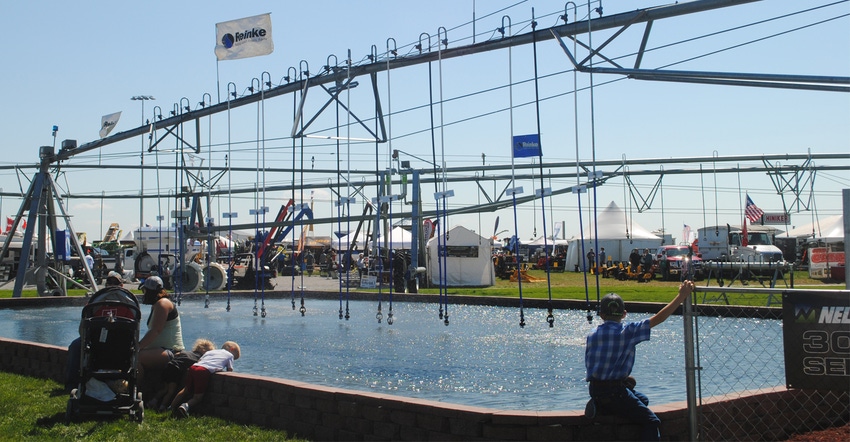
Editor’s note: In our column Then and Now, we look at farm technologies, strategies, equipment, livestock, crops and treatments from our back issues of Nebraska Farmer, and discuss how things have changed and how they have stayed the same.
Looking back at the April 16, 1955, issue of Nebraska Farmer, it is hard to beat the strapline printed across the cover page stating that the magazine is “read in nine out of 10 Nebraska farm homes.” Flipping through the yellowed pages, we landed on a story on Page 28, sandwiched between an ad for Columbian Red Bottom Stock Tanks and Chevrolet’s new line of Task-Force trucks for 1955. The article titled simply “More Irrigation Wells” states that there had been an 18% increase in irrigation wells between the end of 1953 and the end of 1954 in Nebraska, according to the Conservation and Survey Division (CSD). The story even broke down the numbers — county by county — comparing the number of wells in each county between the two years. Buffalo, Dawson, Hall and Merrick counties were by far the leaders in irrigation wells, with each reporting considerable more than 1,000 wells. Dawson County reported 1,640 wells at the end of 1954.
While early irrigation well development was somewhat limited to river and stream valleys, Vincent H. Dreesen, hydrologist for CSD at the time, noted that the “greater percentage of increase in number of wells is occurring away from river valleys.” He said, “The trend in the past two years has been larger increases in counties adjacent to river valleys and in the uplands.”
Just like today, experts cited tight margins and low commodity prices as driving the growth in irrigation, with farmers hoping to boost yields and improve profitability in dry years and even in wet years, through irrigation.
Wells expand
“Irrigation in Nebraska began as early as the late 19th century, when extensive networks of diversion dams and irrigation canals were built to irrigate land mainly in the North Platte, Platte and Republican river basins,” says modern day CSD hydrologist Aaron Young. “Following the drought of the 1930s, drilling and pumping technology advanced rapidly. Some of the earliest irrigation wells were drilled in the Platte River valley, where water tables were shallow, water is abundant, and the land is fertile and flat.”

WELL EXPANSION: This 1955 Nebraska Farmer article reports an 18% increase in irrigation wells in Nebraska from the end of 1953 through the end of 1954. The article also includes a breakdown of the wells in each county in the state.

Young, who authors Nebraska’s annual groundwater levels report, notes that Merrick, Hall and Buffalo counties still have some of the densest areas of irrigation wells in the state, with densities of greater than 16 irrigation wells per square mile in some locations.
Irrigation was exploding in the Great Plains in the 1950s on through the 1970s, Young says. “Large-scale droughts of the 1930s and 1950s placed great economic strain on many dryland producers, and the need for irrigation was realized,” he says. The improvements in drilling and pumps allowed producers to develop irrigation away from the river valleys by drilling deeper and pumping water from the High Plains Aquifer. “In 1954, it is estimated from the original Nebraska Farmer article that there were about 11,500 active irrigation wells in Nebraska,” Young says. “As of 2021, there are now more than 96,000.”
Methods of watering have also changed. In those early days, water was applied through gravity irrigation. “Water was applied first through use of canals and siphon tubes, and later, as pump technology advanced, through the use of wells and gated pipe,” Young says. “By 1959, about 90% of irrigation water was applied through flood irrigation.”
Center pivots
Frank Zybach’s invention of center pivot sprinklers changed all that. Through the refinement of Zybach’s technology, flood-irrigated fields slowly began to be converted to center pivots. The efficiency of water application nearly doubled.
“Although they require a significant upfront investment, they require less maintenance and significantly lower pumping costs,” Young says. “Over the last decade, as water in some areas becomes scarcer, low-flow drip irrigation is slowly being developed,” he explains.
“In 1954, according to the U.S. Census of Agriculture, there were 2.1 million acres of irrigated farmland in Nebraska,” he says. “As of 2017, Nebraska leads the nation in irrigated farmland, with nearly 8.6 million acres.” The 2018 Census of Agriculture reports that 91% of irrigation water in the state is now applied with sprinklers and center pivots, with 9% by gravity flow and less than 1% through modern low-flow or subsurface drip systems.
While irrigation wells have grown in number, and the delivery system of irrigation water on crops has completely changed since 1955, the overall goal of irrigation to improve yields and profits for farmers, has remained constant over that same time period.
About the Author(s)
You May Also Like






